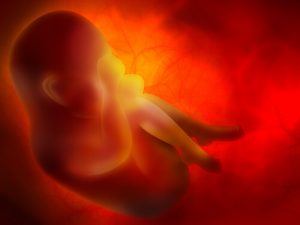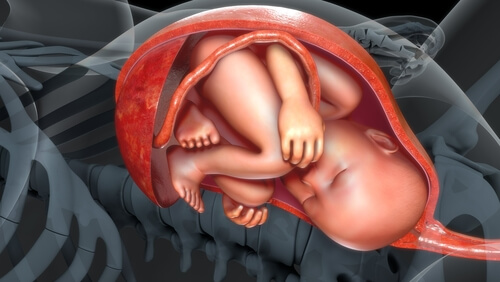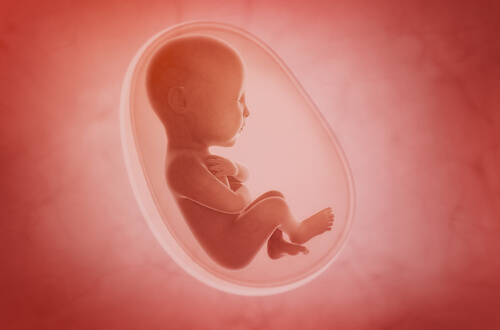The Placenta: the Organ that Feeds Your Baby

The placenta is a fundamental organ during pregnancy and only exists during this stage of life.
It constitutes the vital connection between the baby and the mother, since its main function is to transmit nutrients to the fetus, encouraging it to grow and develop properly.
The word placenta comes from Latin and means “flat cake,” referring to the shape it has in humans. At the same time that the embryo is implanted in the uterine wall (within a week of fertilization), the placenta begins to form.
What is the placenta for?
The placenta is an organ of vital importance for the growth and protection of the fetus. In the first months, it’s barely formed, and the endometrium is in charge of supplying the embryo with nutrients.
The placenta won’t adopt its definitive structure until the 18th week of pregnancy, in which it will begin to fulfill its functions:
- Facilitates the exchange of nutrients and hormones.
- Works as a fetal lung, administering oxygen to the baby.
- Acts as a filter, removing harmful substances and waste. The placenta passes them into the maternal bloodstream, which then eliminates them through the kidneys.
- Manufactures hormones, including human chorionic gonadotropin, which allows the pregnancy to continue.
It also synthesizes estrogen, the female sex hormones. They have a key role in embryo implantation, breast development and placental lactogen. All these hormones collaborate when the woman’s body goes through the necessary changes of pregnancy.

How does the placenta work?
The placenta communicates with the fetus through the umbilical cord. This is composed of two arteries. One is responsible for renewing the blood that flows to the baby, and the other is to transport waste to the mother.
All exchanges occur through the placental barrier. It’s a membrane that selectively blocks a large part of substances potentially harmful to the fetus.
The proper functioning of the placenta is essential for the health and proper development of the baby.
Many microorganisms, such as bacteria, germs and toxins, cannot cross the placenta. Thus, the baby is protected at a stage when his immune system is not mature. However, most viruses are able to cross or break this barrier, so it’s important to prevent infections.
Composition and location
The placenta consists of several layers, which come from a maternal component – the uterine membrane or mucosa transforms into part of the placenta – and a fetal component, the trophoblast. This fetal side is composed of hundreds of blood vessels.
The part of maternal origin is the outer part of the placenta. It’s in contact with the uterine wall, which is why it’s known as a basal plate. It also consists of a combination of embryonic tissue and maternal tissue.
As for its location, the placenta is implanted and attached to the uterine wall. Normally, it’s on the anterior or posterior side of the uterus, without obstructing the cervix, where the baby will be born. When it’s located in the lower part of the uterus, it’s called a placenta previa.

Life of the placenta
Like any other organ, the placenta has a biological process: it is born, it grows and it dies. However, this organ differs from the rest in that it lasts the same as pregnancy: 40 weeks, approximately.
It grows throughout pregnancy, except in the last weeks, when its development stagnates.
As of week 41, there is an increased risk that it will stop working properly. This is what is known as an old, aging or hypermature placenta. It forms calcifications, which can cause the placenta to no longer properly nourish the fetus.
At the end of pregnancy, it usually measures between 1.5 and 3 centimeters thick and 15-20 centimeters in diameter, weighing around 450-550 grams. Delivery is not over until the placenta is expelled in the very last phase. At this stage, there are still contractions.
Once it’s expelled, it’s important to check that the placenta is complete. This is because complications can occur if part of the placenta remains inside the uterus.
In addition, by monitoring the state of this organ, you can obtain clues about the baby’s state of health and development.
The placenta is a fundamental organ during pregnancy and only exists during this stage of life.
It constitutes the vital connection between the baby and the mother, since its main function is to transmit nutrients to the fetus, encouraging it to grow and develop properly.
The word placenta comes from Latin and means “flat cake,” referring to the shape it has in humans. At the same time that the embryo is implanted in the uterine wall (within a week of fertilization), the placenta begins to form.
What is the placenta for?
The placenta is an organ of vital importance for the growth and protection of the fetus. In the first months, it’s barely formed, and the endometrium is in charge of supplying the embryo with nutrients.
The placenta won’t adopt its definitive structure until the 18th week of pregnancy, in which it will begin to fulfill its functions:
- Facilitates the exchange of nutrients and hormones.
- Works as a fetal lung, administering oxygen to the baby.
- Acts as a filter, removing harmful substances and waste. The placenta passes them into the maternal bloodstream, which then eliminates them through the kidneys.
- Manufactures hormones, including human chorionic gonadotropin, which allows the pregnancy to continue.
It also synthesizes estrogen, the female sex hormones. They have a key role in embryo implantation, breast development and placental lactogen. All these hormones collaborate when the woman’s body goes through the necessary changes of pregnancy.

How does the placenta work?
The placenta communicates with the fetus through the umbilical cord. This is composed of two arteries. One is responsible for renewing the blood that flows to the baby, and the other is to transport waste to the mother.
All exchanges occur through the placental barrier. It’s a membrane that selectively blocks a large part of substances potentially harmful to the fetus.
The proper functioning of the placenta is essential for the health and proper development of the baby.
Many microorganisms, such as bacteria, germs and toxins, cannot cross the placenta. Thus, the baby is protected at a stage when his immune system is not mature. However, most viruses are able to cross or break this barrier, so it’s important to prevent infections.
Composition and location
The placenta consists of several layers, which come from a maternal component – the uterine membrane or mucosa transforms into part of the placenta – and a fetal component, the trophoblast. This fetal side is composed of hundreds of blood vessels.
The part of maternal origin is the outer part of the placenta. It’s in contact with the uterine wall, which is why it’s known as a basal plate. It also consists of a combination of embryonic tissue and maternal tissue.
As for its location, the placenta is implanted and attached to the uterine wall. Normally, it’s on the anterior or posterior side of the uterus, without obstructing the cervix, where the baby will be born. When it’s located in the lower part of the uterus, it’s called a placenta previa.

Life of the placenta
Like any other organ, the placenta has a biological process: it is born, it grows and it dies. However, this organ differs from the rest in that it lasts the same as pregnancy: 40 weeks, approximately.
It grows throughout pregnancy, except in the last weeks, when its development stagnates.
As of week 41, there is an increased risk that it will stop working properly. This is what is known as an old, aging or hypermature placenta. It forms calcifications, which can cause the placenta to no longer properly nourish the fetus.
At the end of pregnancy, it usually measures between 1.5 and 3 centimeters thick and 15-20 centimeters in diameter, weighing around 450-550 grams. Delivery is not over until the placenta is expelled in the very last phase. At this stage, there are still contractions.
Once it’s expelled, it’s important to check that the placenta is complete. This is because complications can occur if part of the placenta remains inside the uterus.
In addition, by monitoring the state of this organ, you can obtain clues about the baby’s state of health and development.
This text is provided for informational purposes only and does not replace consultation with a professional. If in doubt, consult your specialist.








